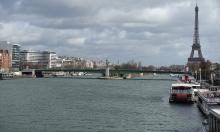Investigators probe charred Taiwanese jet
Aviation officials and police began probing the charred shell of a Taiwanese jet in southern Japan on Tuesday, trying to find out the reason of the explosion occurred just seconds after the 165 people aboard escaped.
The plane's 157 passengers and eight-member crew barely escaped with their lives when a fire engulfed the Boeing 737-800 on the tarmac of Okinawa's Naha airport as it pulled into a parking spot after arriving from Taiwan.
The probe has so far focused on reports from ground personnel that a fuel leak from the right engine could have led to the series of explosions. Boeing and the U.S. government have dispatched experts to help with the investigation.
Japanese aviation authorities and local police conducted an initial check of the wreckage Tuesday, but reached no conclusion over what caused the fire, according to Japan's Aircraft and Railway Accidents Investigation Commission.
News reports said a massive fuel leak from a damaged pipe near the plane's right engine could have led to the explosions. Authorities are also investigating whether any loose plane parts or objects could have been sucked into the engine, damaging the fuel pipe, Kyodo News agency said, quoting unnamed officials.
In Taiwan, China Airlines praised the plane's pilot for supervising a dramatic evacuation of passengers.
Yu Chien-kuo, pilot of China Airlines' Boeing 737-800, jumped from the two-story cockpit window after he saw that all passengers had been evacuated from the plane, said Johnson Sun, the airline spokesman.
Co-pilot Tseng Ta-wei jumped from the same window less than a second ahead of the pilot, Sun said.
"Our pilots were the last to depart," Sun said. "They told the flight attendants to execute an evacuation and help passengers escape within the shortest possible time."
"They did what they should have and acted with great bravery," he said. The entire evacuation took three minutes after ground crew told the pilot they spotted fires on the jet's wings, he said.
The fire started in one of the engines just as the plane pulled into place at Naha airport. With the plane's wings and midsection ablaze, passengers escaped to the tarmac on inflated emergency chutes.
Once the aircraft was empty, and just as the pilot was climbing out of a cockpit window, the jet erupted in a fireball that sent flames and an enormous cloud of black smoke billowing into the sky.
No one was seriously injured. Two passengers were hospitalized because they felt unwell, but not because they were injured in the incident. A ground engineer was knocked off his feet by the force of the blast, but was not hurt.
The cause of the accident remained a mystery Tuesday.
Airport traffic controllers had received no report from the pilot indicating anything was wrong as the aircraft came in to land, and even as it stopped near the terminal to let passengers disembark, according to Japan's Transport Ministry.
Even after landing, passengers reported that nothing was amiss. But as the aircraft came to a halt near the terminal, passengers said they noticed smoke coming from one of the engines and pushed and ran for the exits.
The U.S. Federal Aviation Administration and National Transportation Safety Board are sending investigators to examine the scene. Boeing is also dispatching an investigator in response to a request from the local aviation authorities, company spokesman Jim Proulx said.
The plane had CFM 56 engines, made by CFM International, a joint venture between GE Aviation, a unit of General Electric Co., and France's Snecma, said Proulx. All 737-800s are built with the same engine.
Taiwan's Civil Aeronautics Administration head Chang Kuo-cheng said authorities ordered China Airlines and its subsidiary Mandarin Airlines to ground their 13 other Boeing 737-800s pending a thorough inspection.
Japan's Transport Ministry said Tuesday no problems were found in an emergency inspection of all Boeing 737-800 planes owned by Japanese airlines, as well as some 737-700 models that carry a similar engine.
Boeing has delivered more than 5,400 737s since the plane entered commercial service in 1968, the company's Proulx said. Airlines started flying the 737-800 in 1998, and as of July 31 there were about 1,220 flying worldwide, he added.
A China Airlines 747 crashed in 2002 as it flew from Taipei to Hong Kong, leading to 225 deaths, and some 450 people died in China Airlines accidents during the 1990s.
Subscribe to Pravda.Ru Telegram channel, Facebook, RSS!




